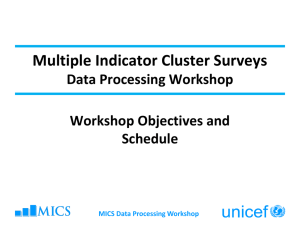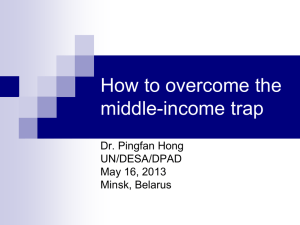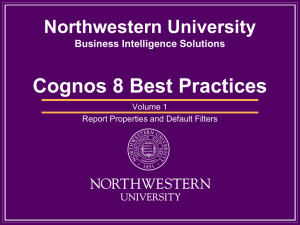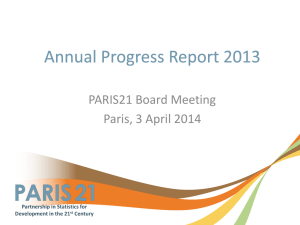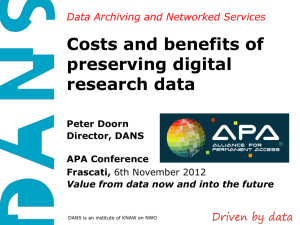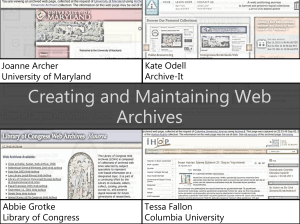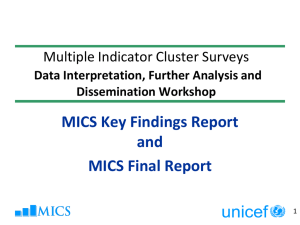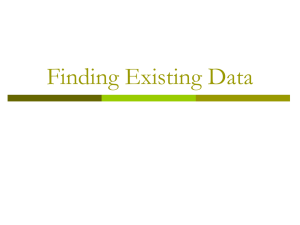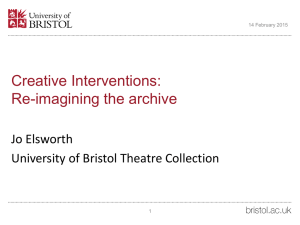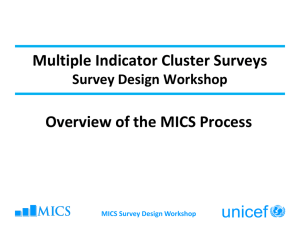Data Archiving
advertisement
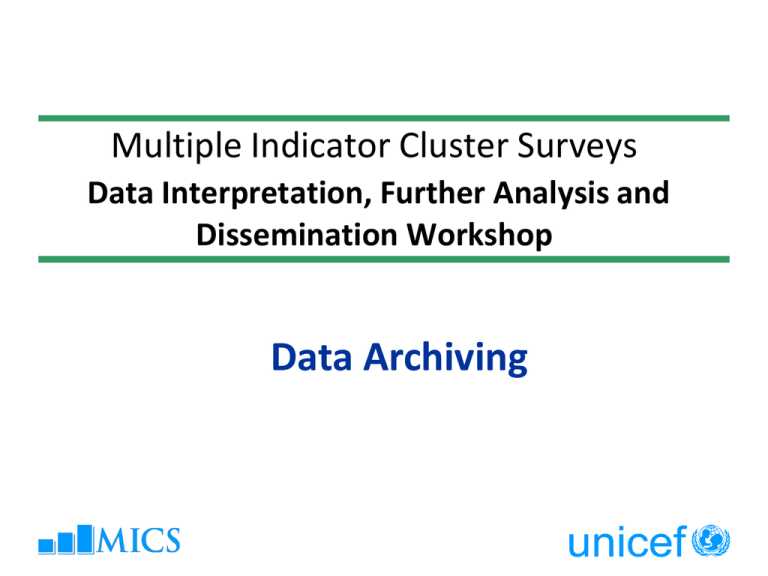
Multiple Indicator Cluster Surveys Data Interpretation, Further Analysis and Dissemination Workshop Data Archiving Look familiar? Today’s storage medium is no longer file cabinets and storage rooms... What is archiving and why do it? Data archiving: rationale Collecting data is expensive. Data should be used beyond producing basic report. Survey microdata are valuable resources for government departments and academic researchers. Survey microdata constitute valuable and irreplaceable assets which should be managed in a way that encourages their widest possible use and re-use. At the same time, data collectors main focus should be protecting respondents while making microdata assessable. Role of MICS data archiving Preservation Documentation Anonymization Dissemination of microdata Why preserve data? Availability for future analysis Examples: Able to examine trends if you have a series of datasets over time Allows in-depth analysis of important subject areas Why document data? Difficult to process without documentation Impossible to analyze correctly Data are useless without documentation Also allows reuse of documents for future surveys Why anonymize data? Protecting the confidentiality of survey respondents - not only because of legal and ethical mandates, but also because of the overall public perception that trust is an important contributor to data quality and response rates. Protecting confidentiality necessitates some sort of data anonymization so that individual respondents can not be identified. Finding balance between protecting the data and compromising its quality. Why disseminate data? Allows wider use of data Allows others to re-analyze data may bring to light issues that may not have been picked up in the original processing. Permits cross-national comparison of data Permits further analysis of data (to be discussed later) Increases acceptability of data Through transparency Demonstrates confidence in survey Who do we disseminate to? The real value of statistical data is in their use Potential users of the data are: •National Policy-makers •International organizations •NGO’s •Academic community •Private enterprises •Others? What do users expect? Well documented data Comprehensive Clear, consistent, easy to use data Information to be able to Fully understand the survey, especially • Sample design, selection and weighting • Field procedures • Data processing • Datasets Accurately analyze and use data When to archive? Start archiving when you start the survey Typically, datasets are documented after completion of the survey MICS Documents to Archive Survey plan and budget Questionnaires Pre-test report Interviewer & field manuals Sample selection, listing information Excel files, other supporting documents Explanations of any event(s) that impacted the sample selection, survey dates, etc Steering/technical committee ToRs and minutes Any other documentation that will help people understand what happened in the design and implementation of the survey MICS Programmes to Archive Software Programmes & Files: • CSPro dictionaries • CSPro data entry & menu systems • CSPro secondary editing & menu systems • CSPro GPS Entry program • CSPro export & SPSS recode • SPSS tabulation programmes • Any country-specific programmes MICS Datasets to Archive • SPSS Files: ‒ Household (HH) ‒ Household listing (HL) ‒ Insecticide-Treated Nets (TN, if included in survey) ‒ Women (WM) ‒ Birth History (BH if included in survey) ‒ FGM (FG, if included in survey) ‒ Children age 0-4 years (CH) ‒ Men (MN, if included in survey) ‒ Maternal Mortality (MM, if included in survey) • CSPro Files: ‒ Final (merged, not individual clusters) HH data file ‒ GPS data (if included in survey) MICS Reports and Dissemination Materials to Archive Key Findings Report Final Report Presentations Factsheets Press releases Videos And everything else! Archives for internal and external audiences If some survey information is considered sensitive or for internal use only then at the end of the survey process it is advisable to create two separate versions of the MICS archive. Restricted MICS Archive (complete archive but only accessible internally) Public MICS Archive (with some documents and information deleted) How do users access data? Types of data Indicators DevInfo, other databases, … Tables, Graphs, Maps Reports, excel files, DevInfo gallery, … Datasets, etc. Formats Print CD-Rom/DVD Web Etc. But how to get the data? Online Write to data producers Conditions on access? • Freely available or restricted? How to Archive? Creating the archive? Recommend to use an archiving tool: International Household Survey Network’s (IHSN) Microdata Management Toolkit http://www.ihsn.org/toolkit Toolkit components Metadata Editor (also known as Nesstar Publisher) Documents survey data in accordance with international standards CD-Rom Builder Generates CD-Rom and web output Nesstar Explorer For viewing metadata and re-exporting data to various formats Step 1: The Metadata Editor All data and documents are first archived in this software. Template-driven specialized editor Imports and exports data to the most common statistical formats Integrated interface, multi-lingual support Compiles metadata and data in single file Installation \Archiving\IHSN Toolkit Full Package\Nesstar Publisher v4.0.9 Install by running: NesstarPublisherInstaller_v4.0.9.exe Nesstar Publisher – first time Open the Nesstar Publisher Select Documentation, Template (or T from the menu buttons) Import Archiving\IHSN Toolkit Full Package\IHSN Metadata Templates • Select IHSN_1.6_en.NesstarTemplate the Study Templates Click Use to use this templates Select Documentation, Template Click Resource Description Templates Import Archiving\IHSN Toolkit Full Package\IHSN Metadata Templates Select IHSN_1.5_en.NesstarRDTemplate from the Resource Description Templates Click Use to use this templates Modifying the example for your survey Select My Projects File, Add New Study (Ctrl-N) Document description Study description Datasets Variable groups External resources Import datasets Click on Datasets Add datasets (Ctrl-I) • • • • HH HL WM MN • • • • CH BH MM FG… Add LN variable to HL file (needed for relations) Insert variable (before HL1) Name: LN, Label: Line number, Width: 2 Click on Data Entry Select Data, and uncheck ‘Write protected’ Copy all cells of HL1 to LN Select Data, and check ‘Write protected’ Completing datasets For each dataset, check key variables and relations Add LN to HL files list of key variables For each dataset, click variables, resequence Validate dataset relations Import descriptions from generic MICS example Documentation, Import, from study Check all boxes, except • • • • variable information variable definitions categories keys and relations Select Generic MICS 5 v1.0 This imports all of the generic document description, study description, variable groups Does not import external resources Save As ..\My survey MICS Izmir WS v1.0 Update for your survey Document description Study description Dataset description Key variables and relations Questionnaire wording Variable groups External resources Thank You 30
